Author: Hank Han, Mint Ventures
1. Introduction
Ethereum staking and its related derivative tracks are undoubtedly the hottest topics in the past one or two years. From Beacon Chain to The Merge, and from LST to DVT to Restaking and LSTfi, we have witnessed the rise and rapid development of staking and related tracks. Looking into the driving factors behind this, we can easily find that its development originates from the paradigm shift of Ethereum staking. Therefore, we should also consider: how will the staking paradigm of Ethereum evolve in the long term, and how will it affect the related tracks and major players.
In his article titled "Protocol and staking pool changes that could improve decentralization and reduce consensus overhead" published on October 7th, Vitalik proposed some optimization solutions for the current Ethereum staking mechanism, providing a reference path for Ethereum to further reduce centralization and consensus overhead. Some of the envisioned changes will have a significant impact on the staking mechanism, while also aligning with the main trends of Ethereum's development. Therefore, we will interpret the article and analyze the potential impact of different solutions on the staking track.
2. Article Review
2.1 Current State of Two-Tiered Staking
Vitalik refers to the current Ethereum staking landscape as two-tiered staking, which involves two layers of participants: Node operators and Delegators.
- Node operators: responsible for operating Ethereum nodes.
- Delegators: users who participate in staking through various means (other than running nodes themselves).
Currently, delegators mainly participate in staking by using services provided by staking service providers such as Lido and Rocket Pool.
2.2 Existing Issues
Vitalik believes that the two-tiered staking model brings two problems: the centralization risk of the staking track and unnecessary consensus layer burden.
- Centralization risk of the staking track: after delegators stake ETH, they need service providers like Lido to select nodes, and the specific selection mechanism may bring centralization risks to node operators from different perspectives. For example, if Lido uses DAO voting to determine operators, node operators may tend to hold a large amount of LDO to increase their market share; Rocket Pool allows anyone to stake 8 ETH to become a node operator, enabling well-funded operators to directly "purchase" market share.
- Unnecessary consensus layer burden: currently, the Ethereum consensus layer needs to aggregate and verify about 800,000 signatures in each epoch. To achieve the goal of Single Slot Finality (SSF), Ethereum will need to aggregate and verify 800,000 signatures in each slot, i.e., the task remains the same, but the time is shortened to 1/32 of the original. This poses higher hardware requirements for running nodes. From the current two-tiered staking structure, most of the verification work is done by node operators, and although there are many validators, the actual entities running validators are not diverse. In other words, the increase in the number of nodes has not reduced the centralization of Ethereum, but has instead increased the consensus burden of Ethereum. Therefore, reducing the number of validation nodes (reducing the number of signatures to be processed) can reduce the consensus burden of Ethereum (which sounds more centralized, and measures to reduce centralization will be explained in the following section).
Background Information Supplement:
Slot: Refers to the time required for a new block to be included in the consensus, with one slot in Ethereum being approximately 12 seconds. In each slot, the network randomly selects a validator as the block proposer, who is responsible for creating a new block and sending it to other nodes on the network. Additionally, in each slot, a validator committee is randomly selected to determine the validity of the proposed block through their votes. Not all validators need to participate in the validation work of a slot, only the selected committee's validators need to participate normally, and a 2/3 vote of the committee can make the status of the slot valid. Not requiring all validators to participate in each slot makes it easier to manage network load.
Epoch: Refers to a time period containing 32 slots, with one epoch in Ethereum being approximately 6.4 minutes. In an epoch, a validator can only join one committee, and all active validators in the network need to provide proof of their "active" status in that epoch. The first slot of each epoch (under normal circumstances) is also referred to as a checkpoint.
Finality: In a distributed network, the "finality" of a transaction means that the transaction becomes part of a block and cannot be changed unless a large amount of ETH is destroyed, causing a blockchain rollback. Ethereum manages finality through "checkpoint" blocks. If a pair of checkpoints (the first slot of adjacent epochs) receives more than 2/3 of the votes from the staked ETH, the newer checkpoint will be upgraded. The newer checkpoint will become "plausible," and the older checkpoint's plausible status from the previous epoch will be upgraded to "final" status. On average, user transactions will be in a block in the middle of an epoch, with about half an epoch remaining until the next checkpoint, indicating that the transaction is finally confirmed for 2.5 epochs, or about 16 minutes (after 0.5 epochs, reaching the next checkpoint; then after 1 epoch, the next checkpoint gains plausible status; then after 1 epoch, the next checkpoint gains final status). Ideally, the 22nd slot of an epoch will achieve the plausibility of the epoch checkpoint. Therefore, the average finality of a transaction is about 14 minutes (16 + 32 + 22 slots).
Single Slot Finality (SSF): Achieving finality immediately after each slot produces a block. Currently, the time required for Ethereum to achieve finality for a block is too long, and most users do not want to wait about 15 minutes for final confirmation of transactions, which also limits the development of applications aiming for high transaction throughput. In addition, the delay between block proposal and final confirmation also creates opportunities for short-term reorganization, allowing attackers to review certain blocks or perform MEV extraction. The mechanism for processing phased block upgrades is also quite complex and is one of the more vulnerable parts of the Ethereum codebase. These issues can be addressed by shortening the finality time to one slot. SSF is part of the Ethereum roadmap under The Merge branch (reference: https://twitter.com/VitalikButerin/status/1588669782471368704/photo/1), and is one of Ethereum's long-term goals. However, the Ethereum team does not expect SSF to be rolled out for several years, as it requires major upgrades such as Verkle Trees and Danksharding as prerequisites.
2.3 Solutions
Vitalik points out that the current delegators have not played their due role and believes that the above two problems can be solved by giving delegators more rights and responsibilities. The two main directions for solving the problems are Expanding delegate selection powers and Consensus participation.
2.3.1 Expanding delegate selection powers
Expanding delegate selection powers means giving delegators a more active role in selecting staking service providers and node operators. Currently, this is partially possible, as delegators holding stETH or rETH can withdraw and stake in another staking pool, but there are limitations, such as the inability to directly choose operators and inflexible withdrawal options.
Vitalik mentions three ways to expand delegators' selection powers:
Better voting tools within pools: Optimizing voting within staking pools, allowing users within the pool to choose node operators themselves, although this does not currently exist. Rocket Pool allows any staker to become a node operator, while Lido is governed by LDO holders to decide on node operators, although Lido has proposed adopting a dual governance model of LDO + stETH (proposal link: https://research.lido.fi/t/ldo-steth-dual-governance/2382).
More competition between pools: Increasing competition between staking pools to provide delegators with more choices. However, long-tail staking pools like LST are at a disadvantage in terms of liquidity, trustworthiness, and dapp acceptance compared to leading projects like Lido, leaving delegators with no choice. Vitalik believes that the issues of liquidity, trustworthiness, and dapp acceptance can be addressed through a series of measures, such as reducing slash penalties to lower the risk faced by delegators, allowing users to withdraw staked ETH at any time to address the liquidity and trust issues of LST, and introducing a unified LST token standard to ensure compatibility and security across different dapps.
Enshrined delegation: Native integration of delegation features directly into Ethereum, such as requiring delegators to choose node operators when participating in staking at the Ethereum protocol level.
2.3.2 Consensus participation
Consensus participation involves allowing delegators to participate in Ethereum's consensus in a more lightweight manner without adding extra burden to the Ethereum consensus. Vitalik acknowledges that many delegators may not want to do this and may only want to hold LSTs, but he also believes that some delegators will actively participate in the consensus. Vitalik provides two implementation solutions: native integration into Ethereum and integration by third-party projects, which will be discussed below.
2.3.2.1 Native Integration into Ethereum
At the Ethereum protocol level, validators are divided into two categories: higher-complexity slashable tier and lower-complexity tier, each responsible for different tasks to ensure the performance and decentralization of Ethereum.
Higher-complexity validators: Responsible for Ethereum's main validation and computation work, requiring constant online presence. Each higher-complexity validator will be required to stake a higher amount of ETH, such as 2048 ETH (as mentioned by Vitalik), and will bear the risk of being slashed. The total number of higher-complexity validators in the network will be limited to 10,000.
Lower-complexity validators: There is no quota limit, no staking threshold, and they can avoid being slashed, only needing to participate in consensus in some slots.
- Sources of lower-complexity validators: Delegators providing ETH to higher-complexity validators through staking service providers, and users in the network who want to independently become lower-complexity validators.
- Possible work modes for lower-complexity validators:
- 10,000 lower-complexity validators will be randomly selected in each slot to vote for the state they support.
- A delegator can send a transaction to declare their online status and willingness to become a lower-complexity validator in the next hour, to vote for the block header they support, and must sign out after completing the work.
- A delegator can send a transaction to declare their online status and willingness to become a lower-complexity validator in the next hour. Each epoch, 10 random delegators will be selected to form a block recommendation list, and over 10,000 delegators will be selected as voters. This group of lower-complexity validators does not need to sign out and their online status expires over time.
- Characteristics of the three work modes: all aimed at preventing 51% attacks by node operators and enhancing Ethereum's resistance to censorship. The first and second modes mainly prevent the reversal of finality, while the third mode focuses more on the network's resistance to censorship, requiring more work from lower-complexity validators.
- Prerequisites for lightweight participation: the need for an ultra-light client for lower-complexity validators to use, allowing them to complete validation work through a mobile app or web interface; this involves research into lightweighting Ethereum clients (such as introducing Verkle Trees and statelessness) to lower the barrier to entry for validators.
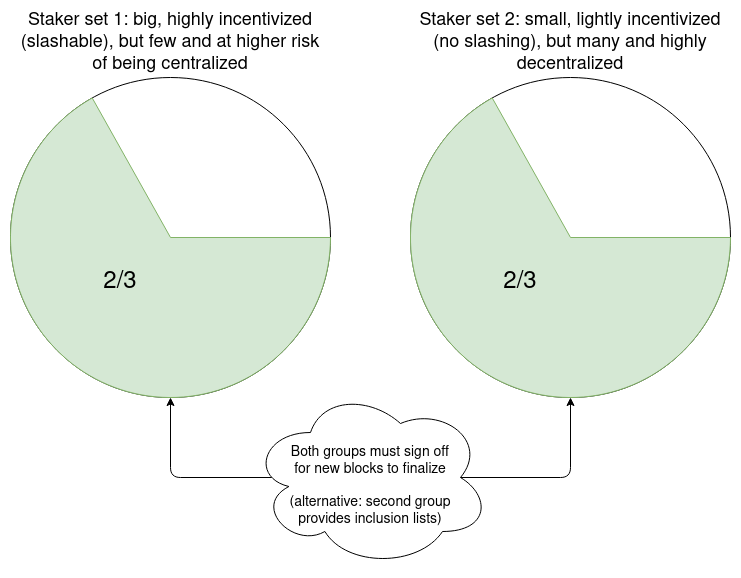
Source: https://notes.ethereum.org/@vbuterin/staking_2023_10
2.3.2.2 Integration by Third-Party Projects
Integration by third-party projects mainly involves upgrading staking pools to enable delegators to participate in Ethereum's consensus. The core idea is to introduce joint signatures from delegators and validators in the consensus voting process to reflect the intentions of the delegator community. The following are three solutions proposed by Vitalik:
When setting up validator accounts, staking pools declare two staking keys, P (persistent staking key) and Q (quick staking key, which is actually the output of an Ethereum address when called). Nodes track the signatures of P and Q for a message selecting a fork. If the choices of P and Q are the same, the validation is successful; if they are different, the validation fails. Staking pools are responsible for randomly selecting delegators as the Q-key holders for the current slot.
Validators generate a staking public key P + Q randomly in each slot, and the voting signature for each slot requires joint computation by validators and delegators. Since a different key is generated for each slot, there are attribution issues related to slashing that need to be addressed.
Place Q into a smart contract, rather than as a key directly held by delegators. The Q managed by the smart contract can introduce diverse triggering conditions, bringing richer voting logic to the staking pool.
2.3.3 Conclusion
Vitalik believes that if the above solutions are implemented properly, adjustments to the proof-of-stake design can achieve dual benefits (reducing centralization in staking and decreasing the load on Ethereum's consensus):
Providing an opportunity for those who currently lack resources or ability to participate in PoS to become more empowered (including the power to choose the nodes they support) and to participate in a more lightweight but meaningful way. Vitalik also points out that not all participants will choose these options, but any chosen solution can improve the current situation.
Reducing the number of signatures that the Ethereum consensus layer needs to process in each slot, even in the case of deterministic finality, to approximately 10,000. This contributes to decentralization, making it easier for everyone to run a validation node.
The above solutions, including optimizing pool elections, increasing competition between pools, and native integration into Ethereum, although at different levels of abstraction, all aim to address the current issues of centralization and consensus load in Ethereum staking. Vitalik believes that specific implementation solutions should be carefully considered before adoption, and the optimal solution should achieve the desired goals while minimizing protocol changes.
3. Impact Analysis on Staking-Related Tracks
3.1 Overview of Staking-Related Tracks
Referring to @StakingRewards' classification of the Ethereum staking ecosystem, it can be divided from the bottom up into the validator layer, staking layer, bridging layer, DeFi infrastructure layer, and the top layer of structured products. The internal logic and respective values can be summarized as follows:
Validator Layer: Represented by P2P, Stakefish, and other node operators, it provides the most basic hardware resources for the staking layer or solo stakers. This also includes service providers such as SSV and Obol, which offer DVT technology. The validator layer addresses hardware-related issues for the staking layer.
Staking Layer: Represented by staking service providers such as Lido and Rocket Pool, it receives funds from delegators and acts as an intermediary between delegators and node operators to conduct Ethereum's consensus validation. This also includes EigenLayer, which introduces the concept of restaking. The staking layer encapsulates the indirect participation of delegators in PoS into financial products, lowering the entry barrier and bringing more staking shares to Ethereum.
Bridging Layer: This refers to the issuance of Liquid Staking Tokens (LST) by the staking layer. Users participate in various DeFi protocols through LST, and staking service providers add LST-ETH trading pairs in protocols like Curve to provide liquidity for delegators, reducing the opportunity cost of participating in staking.
DeFi Infrastructure and Structured Product Layer: Developing derivative products and services based on the value storage and earning capabilities of LST, creating more applications for LST, enriching the DeFi ecosystem, and attracting users to participate in staking.

In the staking ecosystem, the staking layer plays a pivotal role in introducing more staking shares to Ethereum and providing liquidity to the DeFi system through LST. The central position of the staking layer means that its changes can cause changes in the entire staking ecosystem. Therefore, we will focus on analyzing the potential impact of the proposed solutions on staking layer projects in this article. The staking track in this article mainly refers to the staking layer.
3.2 Potential Impact of the Above Solutions on the Staking Track
The above solutions, although from different implementation perspectives, will have an impact on the staking track. We will analyze the impact of different solutions in the following sections and infer the feasibility of adopting the corresponding solutions.
3.2.1 Expanding Delegate Selection Powers
A brief analysis of the potential impact of the three proposed solutions for expanding delegate selection powers mentioned by Vitalik.
Better voting tools within pools: This involves optimizing voting within staking pools, allowing users within the pool to choose node operators themselves.
- Potential impact: It may make staking service providers more decentralized, but it may not reduce the centralization of the staking track, as users may trust leading staking service providers more. The decision-making power, which was previously more controlled by staking service providers, is partially transferred to delegators, potentially reducing the value capture of governance tokens.
- Feasibility analysis:
- Overall low cost: No need for changes to the Ethereum consensus layer, only requiring staking service providers to change their own mechanisms.
- Lack of incentives for existing staking service providers: This solution requires existing staking service providers to proactively change and incur significant costs, including development costs and a decrease in the utility of governance tokens.
- Conclusion: It partially addresses the issue of staking centralization but may not solve the consensus load issue, resulting in a moderate overall impact. The implementation cost is relatively low, but existing staking service providers may lack the motivation to adopt it. There may be new staking service providers entering the market with this feature.
More competition between pools: This involves strengthening competition between staking pools, allowing delegators to have a wide range of choices. The core differences between different staking pools in attracting users currently lie in the liquidity of LST, trustworthiness, and dapp acceptance. Vitalik proposes reducing slash amounts and introducing a unified LST standard to minimize these differences and enhance competition between staking service providers.
- Potential impact: Reduced differences among staking service providers, leading to a decrease in market share for leading projects like Lido, thereby reducing the centralization of the staking track. The LSTfi ecosystem may become more prosperous, as corresponding dapps can support LST from more staking pools. Staking service providers may seek differentiation in other aspects, with competition potentially shifting towards the staking returns of LST, especially in MEV extraction strategies.
- Feasibility analysis:
- Overall moderate cost: Low technical costs, as this solution does not require changes to the Ethereum consensus layer, only the introduction of a new unified LST token standard and cooperation from staking service providers to reduce users' slash amounts and adopt the new LST standard. However, a significant migration cost exists as a large number of existing LST holders would need to exchange their LST for the new unified standard.
- Lack of incentives for existing staking service providers: This solution requires existing staking service providers to make proactive changes, incurring upgrade development costs and the risk of a decrease in market share. The adoption of this solution also puts pressure on existing service providers to maintain their market share.
- Conclusion: It largely addresses the issue of staking centralization but may not fully solve the consensus load issue. The overall implementation cost is moderate, but existing staking service providers may lack the motivation to adopt it. There may be new staking service providers entering the market with this feature.
Enshrined delegation: This involves directly incorporating the delegation functionality into the Ethereum protocol layer, such as allowing users to directly choose node operators and Ethereum introducing a unified LST token standard.
- Potential impact: Similar to the impact of the more competition between pools solution, but the support from the Ethereum protocol layer would to some extent ensure the security of the corresponding transition. It may add to the burden of the Ethereum consensus, as user participation in delegation at the Ethereum protocol layer would bring more validation work to the Ethereum consensus.
- Feasibility analysis:
- Overall high cost: It requires an upgrade to the Ethereum consensus layer to natively support the delegation functionality.
- Potential contradiction with the upgrade's original intent: It adds to the burden of the Ethereum consensus; allowing delegators to directly choose node operators through the protocol layer is essentially closer to DPoS, which may not be the desired outcome for Vitalik.
- Conclusion: It largely addresses the issue of staking centralization but may exacerbate the consensus load issue. Additionally, the cost of the upgrade is high, requiring significant changes to Ethereum. The likelihood of adoption is extremely low.
3.2.2 Consensus participation
The basic idea of consensus participation is to involve more simple validators in the consensus. The difference between the two solutions lies in whether it is implemented through native integration into Ethereum or within third-party projects.
3.2.2.1 Native Integration
According to Vitalik's idea, the native integration solution for Ethereum will directly divide the network into two groups: complex validators and simple validators. The staking threshold for complex validators will be raised to 2048 ETH, with the number of validators limited to 10,000, requiring real-time online presence and being responsible for primary validation and computation work. On the other hand, simple validators only need to run a lightweight client on their devices, participate in consensus at specific times, and only handle lightweight tasks such as voting.
Note: 2048 ETH is an example mentioned by Vitalik in the original text, but it has a high likelihood of being the adopted figure in subsequent solutions. Considering Vitalik's explanations in the article "Paths toward single-slot finality" and the EIP-7251 referenced by Vitalik in the original text, we can infer that this number has practical significance: 2048 ETH can limit the number of validators in a balanced state to an ideal level, reducing the consensus burden on Ethereum and paving the way for achieving SSF. Additionally, in the article "Protocol and staking pool changes that could improve decentralization and reduce consensus overhead," Vitalik proposes a practical approach: Ethereum can first integrate EIP-7251 as a transition, i.e., raise the validator balance limit to 2048 ETH while retaining the 32 ETH minimum; then use 2048 ETH as the overall staking limit to allow validators to self-select into tiers. Therefore, analyzing with the figure 2048 ETH has significant reference value in the following analysis.
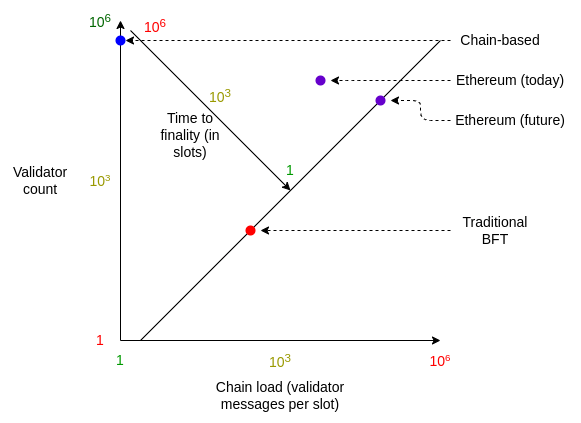
- Potential Impact
- Simultaneously addressing staking centralization and Ethereum consensus load issues: Native integration provides a simple, low-cost way for delegators and other ordinary users to participate in consensus, significantly increasing the decentralization of the Ethereum network. Additionally, the limit of 10,000 complex validators reduces the difficulty of consensus and the size of aggregate signatures per slot, reducing the consensus burden on Ethereum.
- Increased value of staking service providers' services and security technologies: Individual complex validators will need to actively participate in network validation and maintain high online presence, raising the hardware maintenance threshold and highlighting the value of security technologies like DVT. The 2048 ETH staking threshold will redirect many users who could previously solo stake towards becoming delegators. Overall, the penetration rate of staking service providers and DVT technologies will increase.
- Staking track market size may reach a ceiling: In Vitalik's vision, the participation of simple validators involves running ultra-light nodes independently. ETH staked by delegators will not create more TVL for staking service providers from the delegators' side, and users becoming simple validators do not need to become delegators through staking service providers, as they need to run ultra-light nodes and do not need to be hosted by staking service providers and pay corresponding hosting fees. Therefore, staking service providers will reach a TVL limit of 2048 million ETH.
- Long-term growth of staking service providers and related projects may stagnate
- Short to medium-term growth is still possible but lacks momentum: Despite the current market size, with the total supply of ETH stabilizing at around 120 million after EIP-1559 and the Merge, the staked ETH is approximately 28 million, with a staking rate of about 23.29%. There is still room for improvement in the staking track. However, the growth of ETH staking has reached a bottleneck as staking rewards decrease. Without a significant increase in MEV income due to an increase in on-chain transaction volume, the staking quantity will remain in a stable equilibrium, lacking growth momentum.
- Long-term growth of staking service providers and DVT projects will stagnate: From staking service providers like Lido to DVT projects like SSV, their revenue models rely on charging a certain percentage of fees on this staked amount. When the delegators' upper limit is 2048 million ETH, this amount will be less than the current 28 million. If future MEV income does not increase sufficiently (indicating insufficient staking rate increase), the absolute income scale of the staking track will not increase and may even decrease in the long term.

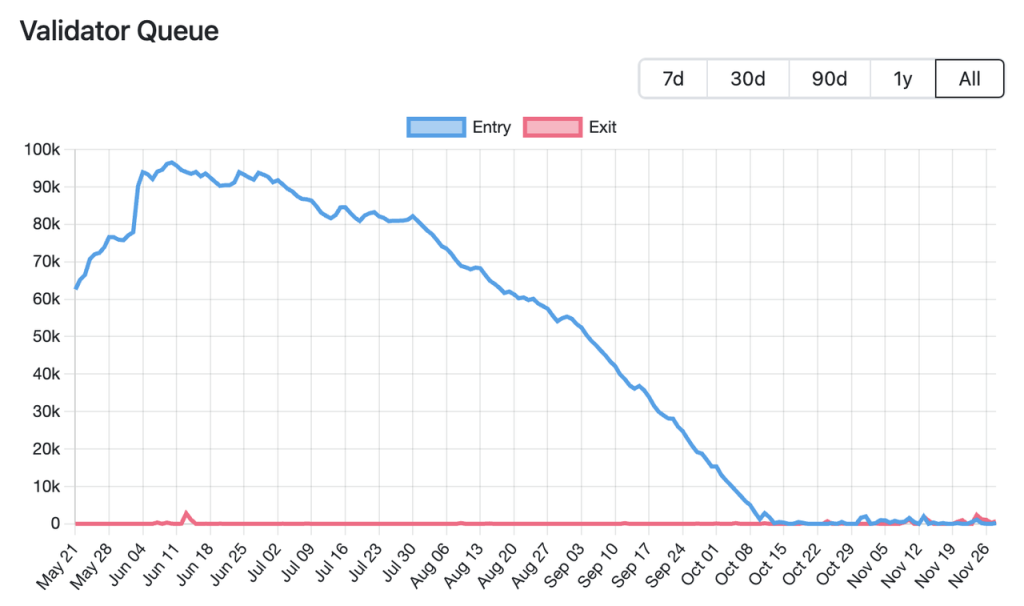
- Feasibility Analysis
- Overall high cost: Requires changing Ethereum's consensus participation rules.
- Aligns with Ethereum's long-term development interests, and the validator tiered architecture may be introduced in the long term.
- One of Ethereum's long-term development goals requires the introduction of a similar validator tiered architecture: Vitalik pointed out in "Endgame" that as the blocks grow larger (state bloat issue), in the future, only a few hundred large nodes will have the conditions to run full nodes. Ethereum needs to find another lightweight way to involve more people in consensus to ensure acceptable trustlessness and censorship resistance. Additionally, to achieve features like single-slot finality (SSF) to enhance Ethereum's performance and security, two types of validators are needed to work together. The responsibilities of the two types of validators differ, making tiered staking rules reasonable.
- The validator tiered structure has appeared multiple times in the Ethereum roadmap and related articles, with a significant amount of research and planning for lightweight client-related solutions to enable simple validators to participate in consensus.
- From important upgrades like PBS, Danksharding, we can see a similar tiered and division of labor concept: allowing specialized nodes to handle more heavy work (such as storing blobs, building blocks) to ensure efficiency, and involving more lightweight nodes in consensus to ensure decentralization.
- From the main ideas in "Endgame," we can see that SNARKification (lightweight) of validation is a reference for simple validators to participate in consensus. In the Ethereum roadmap, we can also see that research including statelessness, The Verge, etc., is preparing for users to run ultra-light nodes.
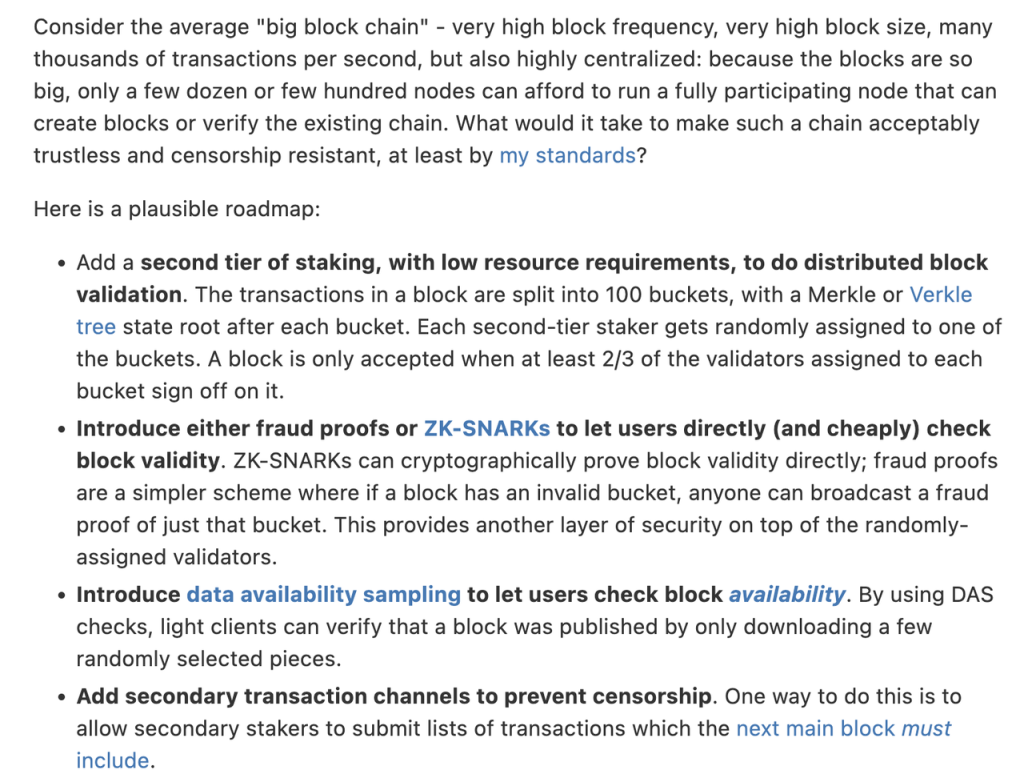
Vitalik: Endgame>, Source: https://vitalik.ca/general/2021/12/06/endgame.html

The Verge related content, Source: https://twitter.com/VitalikButerin/status/1588669782471368704
- Conclusion: Simultaneously addresses staking centralization and consensus load issues. Adoption cost is extremely high, requiring a change in Ethereum's PoS rules, but aligns with Ethereum's long-term development interests, and some preparatory work is already reflected in the Ethereum roadmap. It may be adopted in the long term but has a low likelihood of short-term implementation.
3.2.2.2 Third-Party Project Integration
Vitalik also proposed a solution that is implemented solely through staking pools without native support from Ethereum. The core idea is to split the validator's private key into P and Q, given to the validator node and the user, respectively, and allow users to participate in consensus through the joint signature of P and Q.
- Potential Impact: Can partially address staking centralization, but the effect is uncertain as the user participation process is relatively complex, and the willingness to participate may be low. This solution is more of an internal adjustment for staking service providers and has little impact on the track's landscape.
- Feasibility Analysis
- Moderate implementation cost: No need for significant changes to the Ethereum consensus layer, but existing staking service providers need to undergo complex upgrades, including key splitting, custody, and joint signature design, while also attracting user participation in simple consensus validation.
- Increased cost burden for staking service providers, existing projects may lack incentives for upgrades: Key splitting and custody, as well as user UX design, will bring a certain upgrade cost to existing staking service providers, but may not lead to higher profits for existing service providers.
- The more complex validation logic may add to Ethereum's workload: More complex validation logic includes comparing P and Q signature messages, and more.
- Conclusion: Can partially address staking centralization, but the effect is uncertain, and it has little impact on the landscape of track projects. Existing projects have a low likelihood of adoption, but there may be new staking service providers entering the market with this feature.
3.3 Conclusion
Vitalik did not explicitly express a preference for a particular solution in the article, but we can still infer potential outcomes by analyzing the effects and impacts of the solutions, combined with Vitalik's previous articles and the Ethereum roadmap.
For the three solutions in the direction of Expanding delegate selection powers
- Incomplete problem resolution: The solutions related to Expanding delegate selection powers mainly optimize the issue of staking centralization, but the effectiveness of the solutions is uncertain. This is because the current dual-layer staking structure around delegators-staking pools is essentially close to DPoS, and the solutions for Expanding delegate selection powers do not break the existing structure, and may even highlight the characteristics of DPoS. Additionally, these solutions do not address the issue of Ethereum consensus load, and the native integration of delegation may add to the consensus burden on Ethereum.
- Limited incentive for adoption by existing entities: The solutions in this direction will harm the interests of existing staking service providers, and the solutions that optimize intra-pool elections and enhance inter-pool competition also require the support of staking service providers. Therefore, the incentive for existing staking service providers to adopt these solutions is limited.
- Short-term adoption by new projects is possible: New staking service providers may enter the market with a more decentralized feature, competing with existing projects.
For the Consensus participation direction solutions
- Native support solutions may be a long-term resolution: Native support solutions can simultaneously address the staking centralization and Ethereum consensus load issues mentioned by Vitalik. Additionally, preparatory work for a similar tiered validator architecture is underway. While it may be difficult to achieve in the short term, it is highly likely to occur in the long term.
- Third-party integration solutions, relative to Expanding delegate selection powers, can to a greater extent address the issue of staking centralization, but they also do not resolve the consensus load issue. Similar to Expanding delegate selection powers, there is also the issue of limited incentive for adoption by existing entities, and new staking service providers may enter the market with this feature in the short term.
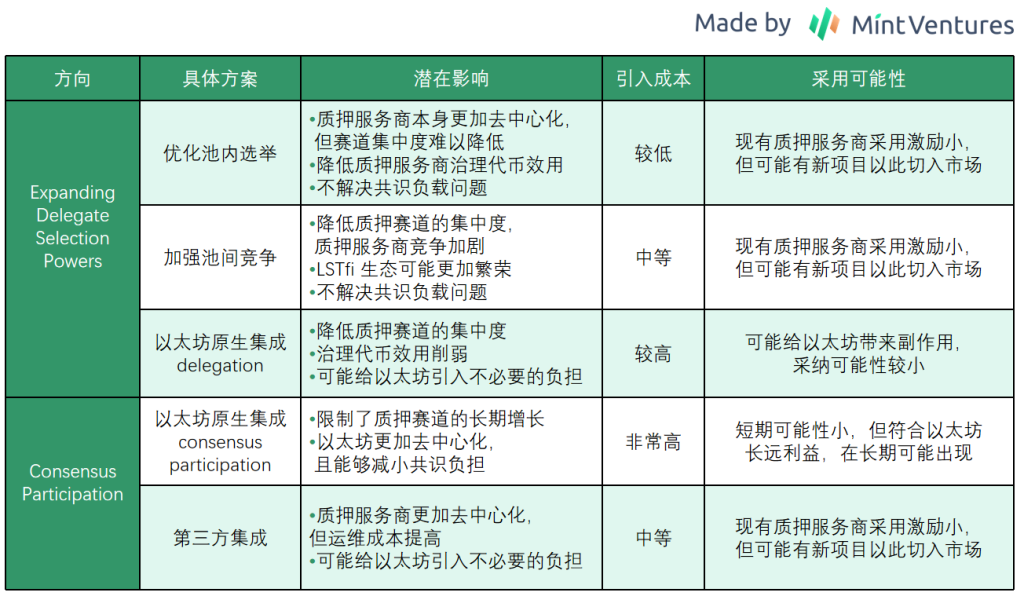
4. Conclusion
In Vitalik's numerous speeches and articles, we can see a core idea: Ethereum should remain neutral and minimalist. Although many features (such as account abstraction, liquidity staking services, privacy accounts, etc.) have enhanced Ethereum's competitiveness, Ethereum has not chosen to directly integrate all features, instead leaving some functionality to be developed by third-party projects. Many third-party projects have effectively addressed the propositions left by Ethereum and found their market positioning. However, as Ethereum continues to evolve, the challenges and opportunities for third-party projects are also changing. For these participants, this is not only an adaptability test but also a moment for thoughtful consideration of the future and seizing endgame opportunities.
In this analysis, we attempted to deduce the potential variables that current staking track-related projects may face in the future based on Vitalik's vision. Although Vitalik has planned the possible endgame for Ethereum in related articles, the future is still full of uncertainty, as current plans may change with new market demands and technological advancements. In this ever-changing landscape, only players with endgame thinking and the ability to capture current window of opportunity can maintain a leading position in the long-term competition.
References
- Protocol and staking pool changes that could improve decentralization and reduce consensus overhead>
- Should Ethereum be okay with enshrining more things in the protocol?>
- Paths toward single-slot finality>
- Etheream Roadmap: Single slot finality
- A Proof of Stake overview>
- Can we find Goldilocks? Musings on “two-tiered” staking, a native Liquid Staking Token design.>
- Endgame>
- The Beacon Chain Ethereum 2.0 explainer you need to read first>
- FAQ on EIP-7251; Increasing the MAX_EFFECTIVE_BALANCE – HackMD
免责声明:本文章仅代表作者个人观点,不代表本平台的立场和观点。本文章仅供信息分享,不构成对任何人的任何投资建议。用户与作者之间的任何争议,与本平台无关。如网页中刊载的文章或图片涉及侵权,请提供相关的权利证明和身份证明发送邮件到support@aicoin.com,本平台相关工作人员将会进行核查。




